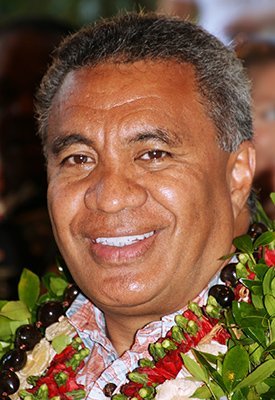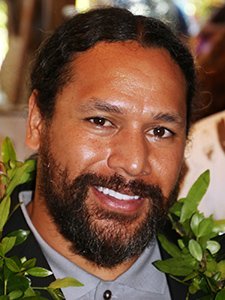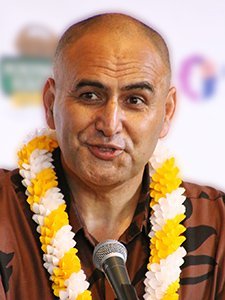Two of the five men honored during the Polynesian Football Hall of Fame enshrinement activities at the Polynesian Cultural Center on January 30, 2016, have close personal ties to Laie. One of them, the first Tongan to play in the NFL, took extra time to explain those ties and share a special message: Education is the goal young athletes should chase.
The first “Laie boy,” the late Al Lolotai Jr., received the PFHOF 2016 Contributor’s award. He was born in Sāmoa, but grew up in the community and in 1945 became the first Polynesian to play in the National Football League as a member of the Washington Redskins team. Lolotai later wrestled professionally, returned to Laie to coach at the “new” Church College of Hawaii (renamed BYU-Hawaii in 1974), then worked in American Samoa sports and health education, and passed away in 2002. His wife and other members of his family, represented him during the ceremonies.

Draped in leis, wearing a traditional Tongan tupenu wraparound and ta’ovala mat, and speaking Tongan, Vai Sikahema took the first minutes of his presentation in the enshrinement program in the PCC’s Hawaiian Journey Theater to thank Heavenly Father for many blessings as well as honor his family and heritage.
“If you didn’t figure out how important education is to them,” Sikahema said, referring to the acceptance remarks of several other PFHOF Class of 2016 inductees before a sold-out crowd, “then you missed the entire purpose for this event. I think you heard from them that education is vital to our people.”
“The real key is not football. Football is the vehicle. I’ve always told kids, make football work for you, don’t work for it,” continued Sikahema, who said he and some of the others “were able to leave football on our terms, because we had an education.”
Now a television news anchor in Philadelphia, Pennsylvania, Sikahema earned his historic spot in the PFHOF after specializing for eight years as a running back and punt returner from 1986–1993. He played primarily for the Phoenix Cardinals as well as the Green Bay Packers (one season) and the Philadelphia Eagles NFL teams (two seasons). Prior to that, Sikahema performed similar running duties for the BYU Cougars, including being a member of the 1984 national championship team. He is also a two-time All-Pro and two-time Emmy Award winner.
But he admits, “I left BYU without a degree. I’m ashamed of that. It took me — get this — 16 years after I left BYU to get my degree. It shouldn’t take you that long. I took classes all over the country, everywhere I played; but I work in television now because I played football, and I can talk, and I like it.”
 Sikahema also credited his part-Hawaiian wife, Keala, for his successes, noting that fellow PFHOF inductee Troy Polamalu — who played strong safety for 12 years with the Pittsburg Steelers (2003–2015) — did likewise when he choked up in his acceptance speech, “not about football, but about the contributions of his wife, Theodora, to his career and their family.”
Sikahema also credited his part-Hawaiian wife, Keala, for his successes, noting that fellow PFHOF inductee Troy Polamalu — who played strong safety for 12 years with the Pittsburg Steelers (2003–2015) — did likewise when he choked up in his acceptance speech, “not about football, but about the contributions of his wife, Theodora, to his career and their family.”
“None of what happened to me would have ever happened,” Sikahema said. “My life changed when I met Keala Heder from Kahuku, and she helped me in so many ways find myself, and prepare me for life in ways that my parents couldn’t have. I wanted to quit at BYU, and she told me, ‘Honey, I don’t care if you never play, but if you quit, you’ll live the rest of your life regretting and wondering what would have happened if you just stayed one more year.’”
“I stayed one more year, and guess what happened? I got drafted. I went to the NFL, and she encouraged me,” Sikahema said. “She would hold the stopwatch at Provo High School while I ran 40s, 50s and 60s around the track, 110, 400 meters, and 800 meters until my lungs collapsed.”
“You know how I knew when it was time to retire? When Keala told me it was time. I would have tried to play three or four more years, but Keala told me, ‘Honey, I’ve watched you play and you were already slow, but you’re even slower now. I think it’s time to retire.’ That’s when I knew it was time.”
“Then she told me, ‘You’ve done enough work in TV. Let’s pursue television. We’ve saved enough money. It may take us five or six years to get a good job in a big market. If it comes to that, I’ll go work.’ But she never had to work, because I got a job right away in Philadelphia, and now I anchor the news.”
“I never would have achieved those things if it had not been for Keala, and my four children who are here, my two in-laws, and my three grandsons and a granddaughter that’s coming. I love you all. We have created Team Sikahema out of just the two of us. We’re strong. We’re proud, and we express our deep appreciation and love from our ohana [family] to you. Mālō ‘aupito [thank you].”
Sikahema also praised his parents and Tongan culture. “I’m grateful for parents who sacrificed and sold everything they had to take us children to the New Zealand Temple in 1967. That taught us, without ever teaching us in words as children, how important sacrifice is,” he said.
He also explained that his parents soon after attended Church College of Hawaii, worked at the Polynesian Cultural Center and later moved to Mesa, Arizona. “The fact that I’m here with this class to be enshrined in the very place where our immigration to the States started is deeply meaningful for me,” he said. “I have wonderful memories of Laie: I attended Laie School. My sweetheart, Keala, is from Kahuku.”
“To return to this place to be honored is so humbling. All of us who have spent time here in Laie, and I want to share this with my fellow inductees, we regard this place as hallowed ground.”
“It’s hallowed for many, many reasons: The number-one reason is that there’s a temple of God that’s within the shadows of this building,” he continued.
“I’m also grateful for my culture, for what it means to be a Tongan,” said Sikahema. “When I left home and went to BYU, I was the first Tongan at BYU on football scholarship; and my late mother over and over reminded me, when you have a free weekend, go to Salt Lake where Tongans are. Go to their weddings and their funerals — not to show off, but to be there. Be part of their lives. Celebrate their achievements. I’m grateful for a mother who taught me to do that — to love my people and to care for them.”
In addition to Lolotai, Sikahema and Polamalu – a USC graduate who also stressed education first, other Class of 2016 Polynesian Football Hall of Fame inductees included the late Charlie Ane Jr., a Samoan who played in the 1950s for the Detroit Lions; and Rockne Freitas, a Hawaiian who spent most of his 11-year NFL career with the Detroit Lions. After football, Freitas worked in educational administration.
As part of the Class of 2016, the PFHOF also named Mike Iupati, a Samoan with the Phoenix Cardinals as the inaugural professional Polynesian player of the year; and Ronny Stanley, a part-Samoan at Notre Dame who is expected to go very early in the upcoming draft, as the college Polynesian football player of the year.
At the beginning of the enshrinement events, PFHOF co-founder Jesse Sapolu (along with Ma’a Tanuvasa) noted, “We’re very, very honored to have our hall of fame here at the Polynesian Cultural Center.”
The PFHOF partnered with the Polynesian Cultural Center about 30 months ago to establish a permanent gallery near the front entrance where each class of inductees is prominently featured.

“Remembering our grand heritage and our noble birthright isn’t enough,” responded Polynesian Cultural Center president and CEO Alfred Grace. “We must also inspire our youth to achieve great things. We are really delighted to have the hall of fame here, because it not only inspires all people of all ages, it especially inspires our Polynesian youth.”
“They can learn from the great accomplishments of people who have gone before them, who had great God-given talents, commitment, perseverance and sacrifice. They did all of that to become who they are; and because of that, they are featured right here in this hall of fame.”
“It is our hope that through the pride they had in their heritage, and the example of those whose names are recorded in the Polynesian Football Hall of Fame they will be inspired to do truly great things,” Grace continued, “be it on the football field, or in the boardroom, and most of all within the four walls of their own homes.”
In emceeing the 2016 enshrinement program, well-known NFL Network media commentator, studio host and senior NFL.com writer Steve Wyche also pointed out there are currently more than 70 players of Polynesian ancestry in the National Football League, and more than 400 playing in Division I college football.
“In last year’s draft, five of the first 68 players taken were of Polynesian ancestry,” Wyche said, “and we’re probably going to have similar numbers this year, but more selected in the first round.”
The Polynesian Football Hall of Fame gallery is located near the entrance of the Polynesian Cultural Center, and is open free to the public.
Story by Mike Foley

Mike Foley, who has worked off-and-on
at the Polynesian Cultural Center since
1968, has been a full-time freelance
writer and digital media specialist since
2002, and had a long career in marketing
communications and PR before that. He
learned to speak fluent Samoan as a
Mormon missionary before moving to Laie
in 1967 — still does, and he has traveled
extensively over the years throughout
Polynesia and other Pacific islands. Foley
is mostly retired now, but continues to
contribute to various PCC and other media.

Recent Comments